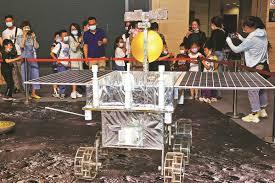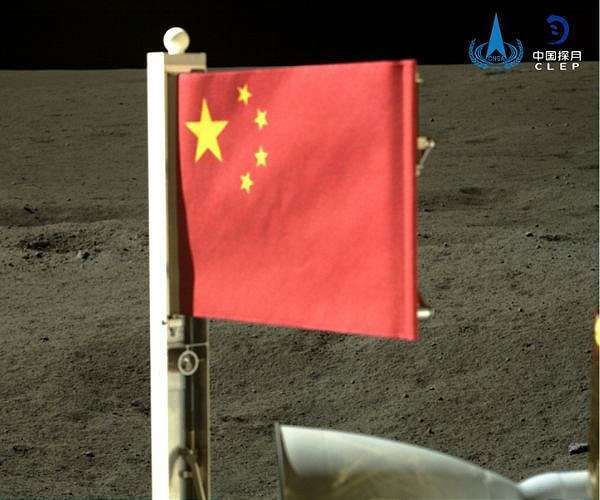24.04.2024
Chinas Change-7 lunar mission to carry instruments developed through intl cooperation

China's Chang'e-7 lunar exploration mission will carry six scientific instruments developed by six countries and one international organization, the China National Space Administration (CNSA) announced on Wednesday.
The Chang'e-7 mission, scheduled for launch around 2026, aims to survey the lunar surface environment, water, ice and volatile elements of lunar soil in the lunar south pole. It will also carry out research on the lunar terrain, composition and structure, the CNSA announced at the launch ceremony of China's Space Day in Wuhan, central China's Hubei Province.
The countries and the international organization participating in the development of the scientific instruments are Egypt, Bahrain, Italy, Russia, Switzerland, Thailand and the International Lunar Observatory Association.
The Chang'e-7 lander will carry laser retroreflector arrays developed by Italy to provide high-precision measurement on the lunar surface and navigation services of the orbiter.
A lunar dust and electric field instrument developed by Russia will be aboard the lander to detect the dusty plasma environment of the lunar surface.
A lunar-based telescope developed by the International Lunar Observatory Association will also be installed on the lander so that observations on the Galaxy, the Earth and the full sky can be made.
The orbiter will carry a lunar hyperspectral camera developed by Egypt and Bahrain to identify the lunar surface material and the lunar environment.
A moon-based, two channel spectrometer for Earth radiation measurement developed through cooperation between Swiss and Chinese scientists will be installed on the orbiter to monitor --for the first time from a lunar perspective -- the radiation incoming to and outgoing from the Earth's climate system.
The orbiter will also be equipped with a sensor package for space weather global monitoring to provide alerts and warnings of magnetic disturbances and radiation due to solar storm.
Quelle: Xinhua
----
Update: 15.07.2024
.
HKU and ILOA Join Forces for Chang'e-7 Moon Lander Mission Set for 2026

The Laboratory for Space Research at The University of Hong Kong (HKU-LSR) has signed a Letter of Intent (LoI) with the International Lunar Observatory Association Hawai'i (ILOA) on May 16, 2024, marking a partnership to participate in the ILOA-led Chang'e 7 lunar mission. This mission features a small, wide-field optical telescope named ILO-C. The HKU-LSR telescope design has been selected, and development is underway. The ILO-C telescope will be installed on the Chang'E-7 lunar lander, set to launch in 2026.
On June 14, a formal Memorandum of Understanding (MoU) was signed in Beijing to solidify broader cooperation in lunar exploration and education. Steve Durst, Founding Director of ILOA Hawai'i, signed the MoU with Professor Quentin Parker, Director of HKU-LSR. Suijian Xue, Group Leader of Sky Survey from the National Astronomical Observatories of the Chinese Academy of Sciences (NAOC), and the National Astronomical Research Institute of Thailand (NARIT) joined the MoU as observers, intending to expand future collaboration.
The ILOA-HKU partnership aims to create a cost-effective, small wide-field telescope camera for the Chang'E-7 mission, focusing on functionality and scientific capability for imaging the Milky Way and the Galaxy center from the Moon.
Steve Durst of ILOA stated, "The ILO-C payload aboard China's Chang'E-7 lander seeks to advance Galaxy imaging, 21st Century Astronomy/Science from the Moon and precursor proof-of-concept development for the ILO-1 flagship mission to Malapert Summit. ILOA, in cooperation with long-time partner NAOC and new collaborator HKU, sees ILO-C as a historic first and advance for the America-China-International Moon cooperation. Also notable, the projected 2026 Chang'E-7 landing area Shackleton Rim is a leading site consideration for the USA Artemis 3 mission attempt to land the first woman and others on the Moon, as early as 2026."
Professor Suijian Xue from NAOC commented, "I am very pleased with the collaborative efforts from HKU-LSR in developing and operating the ILO-C instrument aboard the Chang'E-7 Moon Lander. I greatly appreciate the LSR team's professional diligence and the innovative design solution for the camera, which serves both Galaxy / Astronomy Imaging and 21st Century Science and Education. This collaboration will significantly strengthen the long-term partnership between NAOC, ILOA and now HKU."
Professor Quentin Parker added, "Thanks to an exceptional combined leadership, design and engineering team across the two organizations, and with a true spirit of international collaboration, HKU and the LSR are very proud to be equal partners in this lunar mission for science and education with ILOA. We are particularly honored that our wide-field optical design has been chosen for the ILO-C camera on the Chang'E-7 lunar lander."
Finally, Professor Max Shen, Vice-President and Pro-Vice-Chancellor (Research) of HKU, expressed his excitement about this collaboration, "The Laboratory for Space Research at HKU has once again distinguished itself on the global stage through its selection as an equal partner in the ILO-C Chang'e 7 moon mission. This opportunity is a testament to the calibre of our University's unwavering dedication to international collaboration in pursuing lunar exploration and discovery. We are honoured to work alongside our esteemed counterparts, and I have every confidence that this synergistic partnership will yield significant scientific outcomes that will inspire generations to come."
Quelle: SD
----
Update: 5.02.2025
.
China's Chang'e-7 mission to land on lunar south pole for water ice search: report
China's Chang'e-7 lunar probe, scheduled for launch in 2026, will target the moon's south pole to search for water ice and test cutting-edge technologies critical for sustainable human activities on the moon, China Media Group reported Monday.
The mission using an innovative hopper spacecraft equipped with a water molecule analyzer aims to confirm the presence and distribution of water ice in permanently shadowed craters, said the report.
The Chang'e-3 and Chang'e-5 missions successfully landed on the moon's near side, while Chang'e-4 and Chang'e-6 achieved historic touchdowns on the far side. Therefore, Chang'e-7's planned landing at the lunar south pole will test the capability of China's lunar probe to reach any region of the moon, Tang Yuhua, deputy chief designer of the Chang'e-7 mission, said in the interview.
If lunar water ice is successfully located, it could significantly reduce the cost and time required to transport water from Earth, facilitating the establishment of a human base for long-term activities on the moon and enabling further exploration of Mars or deep space, Tang said.
According to Wu Weiren, the chief designer of China's lunar exploration program, the Chang'e-7 probe - comprising an orbiter, a lander, a rover, and a mobile hopper - will face extreme challenges, including temperatures below minus 100 degrees Celsius and complex terrain.
The hopper, a first-of-its-kind lunar explorer, will "jump" from sunlit areas to shadowed craters to conduct detailed analyses. The lander will deploy China's inaugural deep-space "landmark image navigation" system to ensure precision, while the hopper utilizes active shock-absorption technology to safely land on slopes, said the report.
The probe can autonomously analyze its landing terrain, with more than half of its operations performed independently without requiring ground intervention. The solar panels installed vertically on the probe are being optimized to capture low-angle sunlight near the lunar pole, Tang said, adding that the mission has entered its final assembly and testing phase.
Quelle: Xinhua
